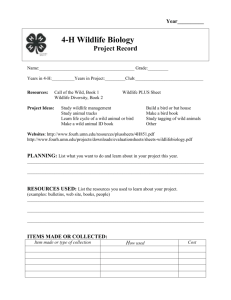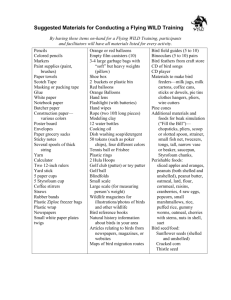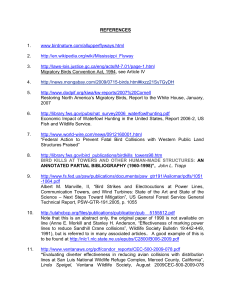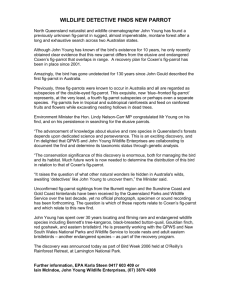“Bird Olympics” Data Sheet - Oregon State University Extension
advertisement
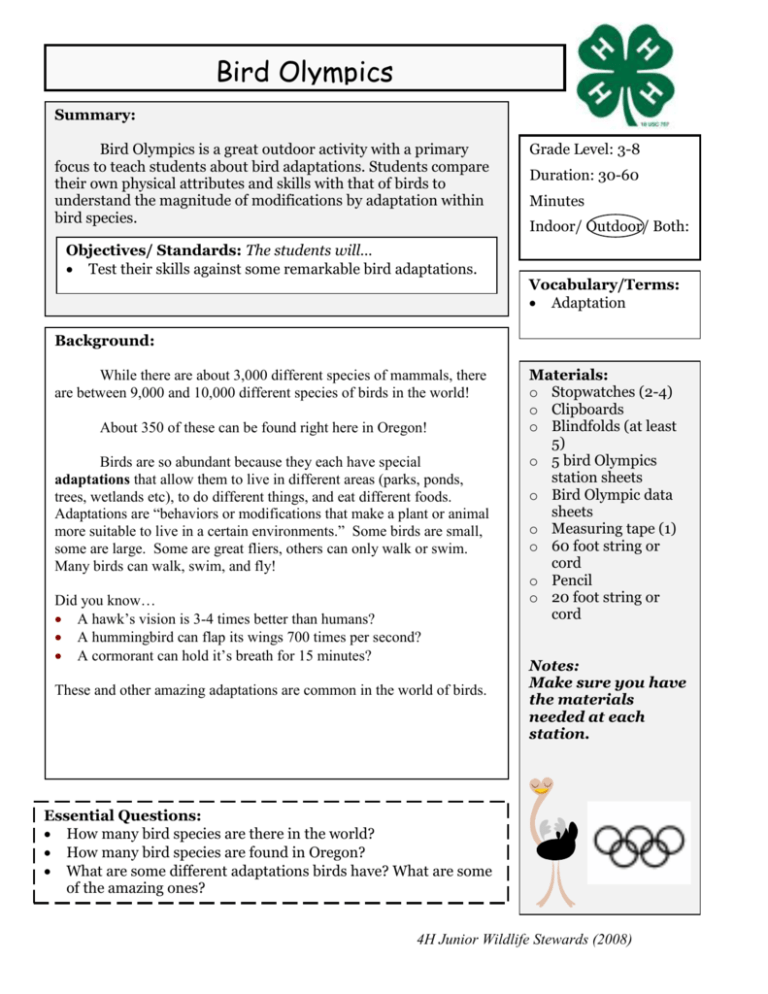
Bird Olympics Summary: Bird Olympics is a great outdoor activity with a primary focus to teach students about bird adaptations. Students compare their own physical attributes and skills with that of birds to understand the magnitude of modifications by adaptation within bird species. Objectives/ Standards: The students will… Test their skills against some remarkable bird adaptations. Grade Level: 3-8 Duration: 30-60 Minutes Indoor/ Outdoor/ Both: Vocabulary/Terms: Adaptation Background: While there are about 3,000 different species of mammals, there are between 9,000 and 10,000 different species of birds in the world! About 350 of these can be found right here in Oregon! Birds are so abundant because they each have special adaptations that allow them to live in different areas (parks, ponds, trees, wetlands etc), to do different things, and eat different foods. Adaptations are “behaviors or modifications that make a plant or animal more suitable to live in a certain environments.” Some birds are small, some are large. Some are great fliers, others can only walk or swim. Many birds can walk, swim, and fly! Did you know… A hawk’s vision is 3-4 times better than humans? A hummingbird can flap its wings 700 times per second? A cormorant can hold it’s breath for 15 minutes? These and other amazing adaptations are common in the world of birds. Materials: o Stopwatches (2-4) o Clipboards o Blindfolds (at least 5) o 5 bird Olympics station sheets o Bird Olympic data sheets o Measuring tape (1) o 60 foot string or cord o Pencil o 20 foot string or cord Notes: Make sure you have the materials needed at each station. Essential Questions: How many bird species are there in the world? How many bird species are found in Oregon? What are some different adaptations birds have? What are some of the amazing ones? 4H Junior Wildlife Stewards (2008) Set-up: Set up the stations from the Bird Olympics data sheet. Be sure to have the appropriate tools at each station. Be sure to emphasize that each station represents an adaptation that the birds have to help them survive in different places. Procedure: Today we are going to play a game called Bird Olympics. This game will teach you about some of the different adaptations birds have to help them survive in different places. By the end of this activity you will: · Know what an adaptation is · Know a few examples of amazing adaptations birds have · Know how you compare to some of the birds around us Visit each station. Ahead of time set up the stations spread out at your site. Be sure to have the appropriate tools needed for each site. At each station, make sure to emphasize that these are ‘adaptations’ that these birds have which help them survive. Notes: The Activity: 1. Divide the class into teams of 2-3 students and explain the activity. 2. Be sure each team has a Bird Olympics Data Sheet. Be sure the needed materials are at each station. 3. Demonstrate how an activity station is completed. You may want to have the class practice collecting data at one of the stations, under your supervision, before sending them to various stations. 4. Send student groups to different stations. Have them rotate from station to station. Teacher monitors student progress by walking around. 5. At the end of the allotted time, gather students into a central location to discuss what they learned. Assessment (how will students demonstrate their understanding?): 1. Ask the students to answer the three questions asked at the beginning. Ex: 2. Review the stations by asking students to name adaptations they learned. What is an adaptation for a bird that can stare for long periods of time? What is an adaptation for a bird that flies for long distances? Relevant Activities/ Games: Build A Bird Bird Beaks Choosing your Food Wisely Go on a Birding tour and watch the birds pick their food 4H Junior Wildlife Stewards (2008) 4-H “Bird Olympics” Data Sheet 1. A White Pelican has a wingspan of 8-9 feet, and a Bald Eagle has a wingspan of 6-7 feet. What is your “wingspan?” Directions: Measure your arms from fingertip to fingertip. (HINT: you need a measuring tape) I have a wingspan of ______feet ______inches! NAME:_____________ I have a wingspan of ______feet ______inches! NAME:_____________ 2. Time to run 60 feet = 40 sec 20 – 39 sec 13.6 - 19 sec 10.2 – 13.5 sec 8.2 – 10.1 sec 6.8 – 8.1 sec 5.8 – 6.7 sec 5.1 – 5.6 sec 4.5 – 5.0 sec 4.1 – 4.4 sec 3.7 – 4.0 sec 3.4 – 3.6 sec 3.1 – 3.3 sec 2.9 – 3.0 sec 2.7 – 2.8 sec ~Miles per hour 1 mph 2 mph 3 mph 4 mph 5 mph 6 mph 7 mph 8 mph 9 mph 10 mph 11 mph 12 mph 13 mph 14 mph 15 mph A roadrunner can run 20 miles/hour. An ostrich can run 40 miles per hour. A Peregrine Falcon can fly up to 200 miles/hour in a dive! How many miles/hour can you run? Directions: Have a friend time you as you run 60 feet. Circle your time on the table below (HINT: you need a stopwatch, 60 feet of cord, and the conversion tables). I can run ______ miles per hour! NAME:________ I can run ______ miles per hour! NAME:________ 3. An owl can stare for hours while hunting for prey! How long can you stare without blinking? Directions: Have a friend time you as you stare at them without blinking. (HINT: you need a stopwatch) I can stare for _______minutes ______seconds without blinking! NAME:______ I can stare for _______minutes ______seconds without blinking! NAME:______ 4H Junior Wildlife Stewards (2008) 4. A cormorant dives deep under water in search of fish. It can hold its breath for about 15 minutes (900 seconds)! Can you hold your breath for even one minute? Directions: Sit down on the ground and hold your nose Have a friend time you as you hold your breath Even if you think you can, don’t go past 60 seconds Remain seated for 30 seconds before standing up again (HINT: you need a stopwatch) I can hold my breath for _____seconds! NAME:_____________ I can hold my breath for _____seconds! NAME:_____________ (Warning: don’t go past 60 seconds)! 5. In 10 seconds, a hummingbird beats its wings 700 times; Chickadee = 270 times; Starling = 45 times; Robin = 23 times; Crow = 20 times; Turkey Vulture = 0-5 times. How many times can you “flap your wings” in 10 seconds? Directions: Have a friend time you as you flap your arms as fast as you can for 10 seconds. (HINT: you need a stopwatch) I can flap my wings _________ times in 10 seconds! NAME:______________ I can flap my wings _________ times in 10 seconds! NAME:______________ 6. A Red Tailed Hawk can see 3-4 times farther than a human. It can even see another bird from 50 miles away! Test your vision compared with a Hawk’s! Directions: Stand 20 feet away from the vision sheets (no cheating!) Use the Hawk vision sheet (SMALL) and record your score (HINT: you need a 20 foot cord and eye charts) I have _____/_____ vision for a hawk! NAME:_____________________ I have _____/_____ vision for a hawk! NAME:_____________________ 4H Junior Wildlife Stewards (2008) 3. Owls Owls need to be able to stare for long times to catch prey at night 4H Junior Wildlife Stewards (2008) 1. White Pelicans Have long wings to be able to fly long distances for long periods of time. These birds migrate and depend on being able to soar for long distances. 4H Junior Wildlife Stewards (2008) 5. Hummingbirds Have to hover to suck nectar so they can flap their wings quickly 4H Junior Wildlife Stewards (2008) 6. Red Tailed Hawk Keen eyesight is necessary for hawks to spot prey from long distances, even when they’re camouflaged in the grass. 4H Junior Wildlife Stewards (2008) 4. Cormorants Fish eating birds have to be able to dive under water for long periods of time to chase and catch fish 4H Junior Wildlife Stewards (2008) 2. Ostrich / Peregrine Falcon Speed is important for hunting and escaping predators. For ostriches, running speed enables them to escape from harm. Peregrine Falcons are one of the fastest creatures on earth when they go into a dive while hunting. 4H Junior Wildlife Stewards (2008) Human Vision Chart 4H Junior Wildlife Stewards (2008) HAWK Vision Chart 4H Junior Wildlife Stewards (2008)

